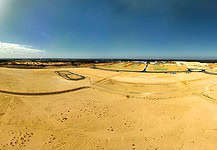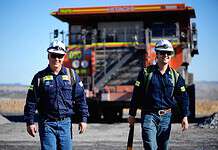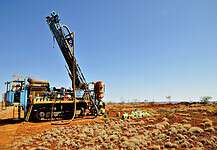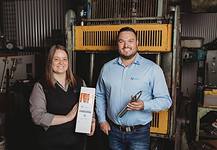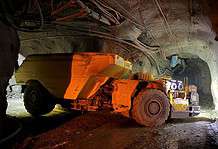All images BHP.
BY ELIZABETH FABRI
THE 2017 financial year was a game changer for BHP and its iron ore division. On top of a corporate rebrand and record production at West Australian Iron Ore (WAIO), plans for BHP’s proposed South Flank project were advancing, with initial funding locked in for early construction.
BHP recently dumped the ‘Billiton’ name in a rebrand aimed at highlighting the company’s Australian roots and rebuilding a dialogue with its stakeholders.
Iron ore has been a key pillar of BHP’s operations for more than 67 years, with WA Iron Ore (WAIO) one of the company’s largest and most successful assets.
“You’re only as good as your last game. Notwithstanding this prosperous history, in the here and now we are facing a well-documented erosion of trust,” Australia President Operations Mike Henry said during a 26 June presentation.
“Society quite justifiably expects companies like mine to not only operate within the law, but to ensure a sustainable quid pro quo in terms of ongoing investment, job creation, upskilling, support to ensure sustainable communities, and of course ongoing opportunities for local businesses to share in the wealth pie.
“Recently investment has slowed, commodity prices and therefore royalties have fallen, businesses like mine have sought to rapidly recalibrate to the new reality by becoming more productive, and that has seen flow on impacts to workers, local business and local communities.
“This has been tough and it’s not surprising that we’ve seen the beginnings of an erosion in support and trust in some quarters.”
While big business does already engage with, and invest in people and communities in a big way, Mr Henry admitted that BHP had not “necessarily done a great job of making sure this is broadly known”.
In the last five years, for example, BHP has invested about $1.6 billion into local Pilbara communities.
“We need to do what we can to engender trust on the part of our stakeholders by building their understanding of the industry and the benefits that already arise from our businesses,” he said.
“And we also need to be willing to step up and be heard on issues of mutual interest. But we need to do more than just get better about how we explain ourselves or how we advocate of how we advocate. We need to continue to lift our game in terms of the way we engage and the way we operate.
“We need to face outward and seek to build bridges just as leaders did at the start of this journey.
“For if we are able to strengthen the foundation of trust in the industry and amongst all stakeholders, then we can assure an industry, economy and communities that continue to advance and which are sustainable for many decades to come.”
In the next few years, BHP plans to bring a new Pilbara mine into production, South Flank, as mining at BHP’s largest iron ore mine Yandi winds down. Mr Henry said the funding would generate several hundred construction jobs and provide exciting opportunities for WA suppliers.
“If approved, the project will require investment of on the order of $3-4bn, will create several thousand construction jobs, many hundreds of ongoing operational jobs, continued opportunities for local business big and small, and of course an ongoing stream of royalties for all West Australians.”
“The $US3.2bn project was expected to generate several thousand jobs during the construction phase, and hundreds of operational positions, which will provide significant flow-on benefits to the WA economy.”
South Flank
Located 10km south of Area C operation, South Flank is BHP’s preferred option to replace production from the 80mtpa Yandi mine when it reaches the end of its economic life.
On 26 June, BHP approved initial funding of $US184 million for the project.
BHP WA Iron Ore asset president Edgar Basto said the Yandi mine would reach the end of its economic life in the early-to-mid 2020s.
“Should South Flank be approved by the board, construction would be expected to start soon after and take several years to complete,” Mr Basto said.
Mr Basto said the project was currently in the feasibility study phase, with first ore targeted in the 2021 calendar year.
“There would be a phased approach to ramping up production to capacity,” he said.
“We will determine the optimum ramp-up/ramp-down times for the transition as we continue to optimise the project, which includes the optimal schedule over which to ramp-down of Yandi and ramp-up of South Flank.”
Mr Basto said the capital cost for the project was expected to be in the range of between $US30 and $US40 per tonne.
“As we have said previously, this expenditure will fit within WAIO’s long-term average sustaining capital expenditure of US$4 per tonne,” he said.
“The use of existing processing, non-processing and logistics infrastructure at Mining Area C is a key component of the investment’s competitive capital intensity.”
WAIO production
In FY17, BHP hit its annual iron ore production target of 231 million tonnes (mt); a four per cent increase from the year prior.
The year also saw record WAIO production of 268mt on a 100 per cent basis, which reflected productivity improvements across its supply chain, including a 12 per cent production in June from the March quarter, and additional capacity at Jimblebar.
“We met guidance for the year and posted the 17th consecutive annual production record in WA iron ore, which was the result of our teams stepping up to sustainably increase utilisation of our installed capacity,” BHP asset president WA iron ore Edgar Basto said.
“Their ideas are not only contributing to reduce costs but also to sustainably increasing productivity in our supply chain.”
In FY17, BHP commissioned a new primary crusher and additional conveying capacity at its Jimblebar mine and processing hub to improve productivity.
A rail renewal and maintenance program was also completed in May 2017.
However, operations at BHP’s Newman iron ore rail line came to an unexpected halt in June following a derailment, restarting at limited capacity.
A large fire at BHP’s Mt Whaleback site near Newman also broke out in June; but this did not impact the company’s full year guidance.
In the 2018 financial year, WAIO production was expected to increase to between 275mt and 280mt on a 100 per cent basis, as BHP continued its work with relevant authorities to increase system capacity to 290mtpa.

Reconstruction efforts at Samarco mine in January 2017.
Samarco restart
In addition to its iron ore operations in the Pilbara, BHP holds a 50 per cent stake in Brazilian iron ore mine Samarco.
The ill-fated joint venture mine has been offline since November 2015 following the tragic Fundão tailings dam burst that resulted in 19 deaths.
In December last year, BHP and its joint venture partner Vale agreed to a non-binding term sheet that outlined a plan to use Vale’s Timbopeba pit to deposit tailings upon Samarco’s restart.
The companies were continuing talks with the Brazil Government to obtain necessary licenses to reopen, however recent reports indicate this was “unlikely” to occur in the 2017 calendar year.
“A restart of operations at Samarco is subject to obtaining separate regulatory approvals and will occur only if safe, economically viable and has the support of the community,” BHP said in a statement.
“Resuming operations would also require government approvals, the granting of licenses by state authorities and the restructure of Samarco’s debt.
“Accordingly, operations at Samarco are unlikely to restart in CY2017.”
On 30 June, BHP approved $US250 million in financial support for the Renova Foundation and Samarco Mineração S.A (Samarco) until 31 December 2017 to go towards remediation, compensation and stabilisation work.
Once the project comes back online, BHP’s group iron ore production was expected to increase.
In FY15, the mine produced 29mt of iron ore (on a 100 per cent basis), and when reopened was expected to run at 60 per cent capacity, and deliver an annual rate of 18mt.
FY18 outlook
Over the next 12 months, BHP said it would continue its focus on improved productivity across its operations.
The company set an iron ore guidance of between 239mt and 243mt, and WAIO guidance (100 per cent basis) of between 275mt and 280mt, subject to regulatory approvals to increase capacity above 290mt.
“We are focused on continuing to improve productivity and safety,” Mr Basto said.
“Inclusion and diversity is also high on my agenda as a leader and delivers value in iron ore and across the company.”
“Our productivity drive is sustainable – in large part because it is underpinned by employee contribution.”
Mr Basto said the company often encouraged employees to contribute ideas to find better ways of doing things and in turn be recognised and rewarded for their work.
“This is what will truly deliver value – for our people and our business,” he said.
“I am part of a new generation of leaders who, rather than working by the muscle delivery model, focuses on collaboration and getting input from all levels in the business – I realise I don’t have all the answers.”
Mr Basto said ideas were generated at all levels, with groups meeting once a week to put forward recommendations.
In FY17, 1949 initiatives were established across WAIO, including 1035 on cost, 316 on culture, 349 on safety, and 249 on throughput.
“That is an increase on FY16 and the result of a focus by the mines to find new initiatives,” he said.
“In the past four years about 5830 ideas have been generated, and about 15 per cent of our employees have come up with initiatives.
“We believe that can increase.”
In the 2018 calendar year, the company said it would double its intake of apprentices in the Pilbara, taking on 200 new apprentices and trainees on top of the 300 already employed.
BHP’s corporate “Think Big” campaign – part of its May rebrand – would also continue.
Mr Basto said planning began more than 15 months ago, and started with BHP asking communities where it operates what their understanding and perceptions of the company were.
“The research showed that while most people knew our name very few people knew what we did, what we stood for or what our commitment was to them and to the broader community but encouragingly, they also said they wanted to know, so we needed to address that,” he said.
“This is the first time since then we’ve come out with a significant national advertising campaign in more than 30 years.
“The purpose of the campaign, in short, is all about us telling our story – to reconnect with our communities.”




